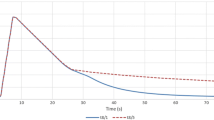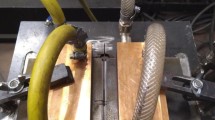Abstract
The effects of forced cooling, meaning forced cooling rate and forced cooling finish temperature, on the tensile and impact toughness properties of simulated weld coarse-grained heat-affected zones have been studied for a commercial grade martensitic steel with a yield strength of 960 MPa. The simulations were done by using a Gleeble 3800 to give forced cooling finish temperatures of 500, 400, 300, 200, and 100 °C and forced cooling rates of 50 and 15 °C/s. For the steel studied, strength significantly increased with no significant negative effects on impact toughness when the steel was cooled rapidly to 200 or 100 °C at 15 °C/s. The results indicate that it may be possible to improve welding productivity and mechanical properties of the steel by using forced cooling down to 100 °C to reduce waiting time between weld passes.








Similar content being viewed by others
References
Javidan F, Heidarpour A, Zhao X-L, Hutchinson CR, Minkkinen J (2016) Effect of weld on the mechanical properties of high strength and ultra-high strength steel tubes in fabricated hybrid sections. Eng Struct 118:16–27. https://doi.org/10.1016/j.engstruct.2016.03.046
Qiang X, Jiang X, Bijlaard FS, Kolstein H (2016) Mechanical properties and design recommendations of very high strength steel {960} in fire. Eng Struct 112:60–70. https://doi.org/10.1016/j.engstruct.2016.01.008
Romero ML, Ibaez C, Espinos A, Portols J, Hospitaler A (2016) Influence of ultra-high strength concrete on circular concrete-filled dual steel columns. Structures 9:13–20. https://doi.org/10.1016/j.istruc.2016.07.001.
Nilsen M, Sikström F, Christiansson A, Ancona A (2017) Vision and spectroscopic sensing for joint tracing in narrow gap laser butt welding. Opt Laser Technol 96:107–116. https://doi.org/10.1016/j.optlastec.2017.05.011
Kim S, Kang D, Kim T-W, Lee J, Lee C (2011) Fatigue crack growth behavior of the simulated {HAZ} of 800 {MPa} grade high-performance steel. Mater Sci Eng A 528(6):2331–2338. https://doi.org/10.1016/j.msea.2010.11.089
X. wei CHEN, B. LIAO, G. ying QIAO, Y. GU, X. WANG, F. ren XIAO, Effect of nb on mechanical properties of haz for high-nb x80 pipeline steels, J Iron Steel Res Int 20 (12) (2013) 53–60. doi: https://doi.org/10.1016/S1006-706X(13)60216-2.
il Jang J, Lee B-W, Ju J-B, Kwon D, sik Kim W (2003) Experimental analysis of the practical LBZ effects on the brittle fracture performance of cryogenic steel HAZs with respect to crack arrest toughness near fusion line. Eng Fract Mech 70(10):1245–1257. https://doi.org/10.1016/S0013-7944(02)00111-X
SSAB, Welding of strenx, www.ssab.com/Products/Brands/Strenx/Products/Strenx-700-MC!tab=workshop, accessed: 2016–02-03
Lan L, Kong X, Qiu C, Zhao D (2016) Influence of microstructural aspects on impact toughness of multi-pass submerged arc welded HSLA steel joints. Mater Des 90:488–498. https://doi.org/10.1016/j.matdes.2015.10.158
Wang X, Wang X, Shang C, Misra R (2016) Characterization of the multi-pass weld metal and the impact of retained austenite obtained through intercritical heat treatment on low temperature toughness. Mater Sci Eng A 649:282–292. https://doi.org/10.1016/j.msea.2015.09.030
Kim J, Yoon E (1998) Notch position in the HAZ specimen of reactor pressure vessel steel. J Nucl Mater 257(3):303–308. https://doi.org/10.1016/S0022-3115(98)00451-6
Wang XL, Tsai YT, Yang JR, Wang ZQ, Li XC, Shang CJ, Misra RDK (2016) Effect of interpass temperature on the microstructure and mechanical properties of multi-pass weld metal in a 550-MPa-grade offshore engineering steel. Weld World 61(6):1155–1168. https://doi.org/10.1007/s40194-017-0498-x
Sung HK, Lee DH, Shin SY, Lee S, Yoo JY, Hwang B (2015) Effect of finish cooling temperature on microstructure and mechanical properties of high-strength bainitic steels containing Cr, Mo, and B. Mater Sci Eng A 624:14–22. https://doi.org/10.1016/j.msea.2014.11.035
Laitila J, Larkiola J, Porter D (2017) Effect of forced cooling on the tensileproperties and impact toughness of the coarse-grained heat-affected zone of a high-strength structural steel. Weld World 62:79–85. https://doi.org/10.1007/s40194-017-0532-z
Kumar S, Nath S, Kumar V (2016) Continuous cooling transformation behavior in the weld coarse grained heat affected zone and mechanical properties of nb-microalloyed and HY85 steels. Mater Des 90:177–184. https://doi.org/10.1016/j.matdes.2015.10.071
Samanta S, Biswas P, Giri S, Singh SB, Kundu S (2016) Formation of Bainite below the MS temperature: kinetics and crystallography. Acta Mater 105:390–403. https://doi.org/10.1016/j.actamat.2015.12.027
Strenx 960 – high-strength S960QL structural steel - SSAB, http://www.ssab.com/products/brands/strenx/products/strenx-960, accessed: 2017–09-08
Bono JT, DuPont JN, Jain D, Baik S-I, Seidman DN (2015) Investigation of strength recovery in welds of nucu-140 steel through multipass welding and isothermal post-weld heat treatments. Metall Mater Trans A 46(11):5158–5170. https://doi.org/10.1007/s11661-015-3087-x
H. Xie, L.-X. Du, J. Hu, G.-S. Sun, H.-Y. Wu, R. Misra, Effect of thermo-mechanical cycling on the microstructure and toughness in the weld {CGHAZ} of a novel high strength low carbon steel, Mater Sci Eng A 639 (2015) 482–488. doi: https://doi.org/10.1016/j.msea.2015.05.033.
(1995) Effect of Yield-Tensile Ratio on Structural Behavior - High Performance Steels for Bridge Construction, R.L. Brockenbrough associates, INC
A. Bannister,(1999)Yield stress/tensile stress ratio: results of experimental programme, British Steel
Acknowledgements
The authors acknowledge Jukka Haapio for providing the basis of the data in Table 2 by conducting the cooling time experiments on the T-joint welds at the company Kemppi Oy in Lahti, Finland. We are grateful to Juha Uusitalo of the University of Oulu for conducting the Gleeble simulations.
Funding
The study received financial support from Tekes—the Finnish Funding Agency for Innovation within the DIMECC program MANU—Future digital manufacturing technologies and systems.
Author information
Authors and Affiliations
Corresponding author
Additional information
Recommended for publication by Commission IX - Behaviour of Metals Subjected to Welding
Rights and permissions
About this article
Cite this article
Laitila, J., Larkiola, J. & Porter, D. Effect of forced cooling after welding on CGHAZ mechanical properties of a martensitic steel. Weld World 62, 1247–1254 (2018). https://doi.org/10.1007/s40194-018-0617-3
Received:
Accepted:
Published:
Issue Date:
DOI: https://doi.org/10.1007/s40194-018-0617-3




